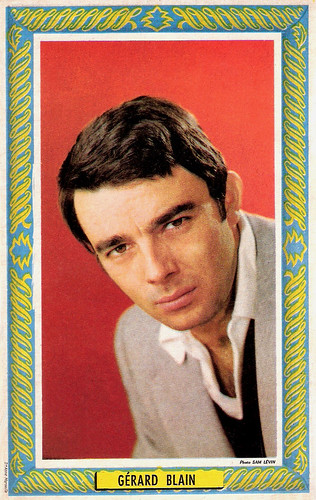
French postcard by St. Anne, Marseille. Photo: Sam Lévin.
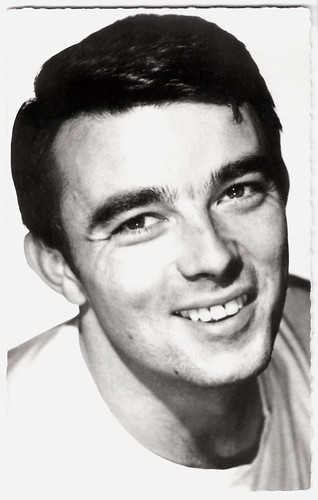
French postcard by Editions du Globe, Paris, no. 836. Photo: Sam Lévin.
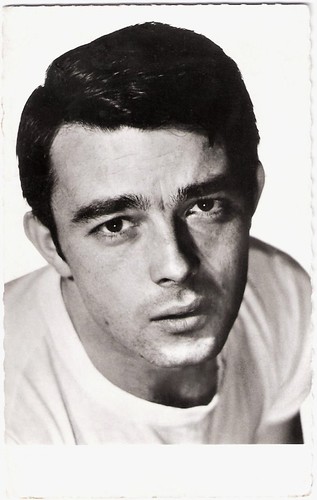
French postcard by Editions P.I., Paris, no. 978. Offered by Les Carbones Korès 'Carboplane'. Photo: Sam Lévin.
Pretty little mouth
Gérard Ernest Zéphirin Blain was born in Paris, France in 1930. He was very young when his father, the chief architect of the city of Paris, left the family home. Gerard's relations with his mother and his sister became confrontational. At 13, he left school without even having a primary school certificate and began an eventful life among street children in the Paris of the Occupation.
This unhappy childhood would later become a recurring theme of his own films, including the highly autobiographical Un enfant dans la foule/A Child in the Crowd (Gérard Blain, 1976).
He made his film debut with an uncredited bit part in Le Carrefour des enfants perdus/Children of Chaos (Leo Joannon, 1944) at the age of 13. In the following years, he continued to work as an extra in Le Bal des passants/The Ball of Passers-by (Guillaume Radot, 1944), a melodrama about abortion starring Annie Ducaux, and the classic Les enfants du paradis/Children of the Paradise (Marcel Carné, 1944) with Arletty and Jean-Louis Barrault.
In 1944, he had a brief stay in the FFI (Forces Françaises de l'Intérieur), the French resistance. After the war, he lead a chaotic life and in 1953, he again began to play in such films as Les fruits sauvages/Wild Fruit (Hervé Bromberger, 1954), opposite his first wife Estella Blain, and Avant le deluge/Before the Deluge (André Cayatte, 1954) starring Marina Vlady.
Looking like a cross between Alain Delon and James Dean, he was noted for his ‘pretty little mouth.’ Finally, director Julien Duvivier gave him his first substantial role in the thriller Voici le temps des assassins/Deadlier Than the Male (Julien Duvivier, 1956) as the son of Jean Gabin. It became his breakthrough in the cinema. Blain was 26 at the time.

French postcard by Editions d'Art Yvon, Paris, no. 210. Photo: Sam Lévin.

Italian postcard by Bromofoto, Milano, no. 1732. Photo: Cineriz. Publicity still fort Via Margutta/Run with the Devil (Mario Camerini, 1960).
The innocence of the outsider
Gérard Blain met the directors of the Nouvelle Vague (the French New Wave) – Jean-Luc Godard, Claude Chabrol – who were born in the same year as he was. Quickly he became one of the faces of the Nouvelle Vague. Another Nouvelle Vague director, François Truffaut, engaged Blain for his second short film, Les Mistons/The Kids (Francois Truffaut, 1957), in which his co-star was his second wife, Bernadette Lafont. They played two lovers who are spied on by 5 kids, les mistons.
In 1958, Chabrol made him a Nouvelle Vague icon with his starring roles in Le Beau Serge/Beautiful Serge (Claude Chabrol, 1958) and Les Cousins/The Cousins (Claude Chabrol, 1958). His antagonist in both films was another face of the Nouvelle Vague, Jean-Claude Brialy.
At Films de France, James Travers writes: “Le Beau Serge brings together three of the actors who would become closely associated with the French New Wave: Jean-Claude Brialy, Gérard Blain and Bernadette Lafont. Whilst each of these actors gives a very credible performance, it is unquestionably Blain who has the greatest impact. Watching Blain in this film, it is hard not to recall James Dean in Rebel Without a Cause (1955). There is vitality and depth to his portrayal that makes him stand out from the film like a character in a children’s pop-up book, yet there is also a wild quality that makes it difficult for us to sympathise with him. (Another feature of Chabrol’s cinema is its objectivity - we rarely, if ever, form any emotional attachment with the protagonists.) Blain’s bestial, child-like Serge makes a startling contrast with Brialy’s civilised man-of-the-world François - the difference in acting styles helps to emphasise the enormous gulf that exists between the two characters.”
About Les Cousins/The Cousins (1958), Travers writes: “Both of the two central characters, Charles and Paul, are played admirably by Gérard Blain and Jean-Claude Brialy. Blain manages to capture the innocence of the outsider and offers a sympathetic and memorable performance”. Gérard Blain also worked with Godard on the short film Charlotte et son Jules/Charlotte and Her Boyfriend (Jean-Luc Godard, 1960) with Jean-Paul Belmondo. Later Jean-Pierre Mocky directed him in Les vierges/The Virgins (Jean-Pierre Mocky, 1962).
In Italy he also appeared regularly in films, including Giovani mariti/Young Husbands (Mauro Bolognini, 1958) with Isabelle Corey, I delfini/Silver Spoon Set (Francesco Maselli, 1960) opposite Claudia Cardinale, and the war drama Il gobbo/The Hunchback (Carlo Lizzani, 1961) with Anna-Maria Ferrero.
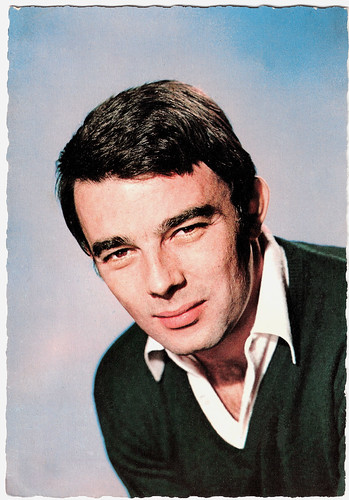
French postcard by E.D.U.G., no. 62. Photo: Sam Lévin.

French postcard by Editions P.I., Paris, no. FK 124. Photo: UFA.
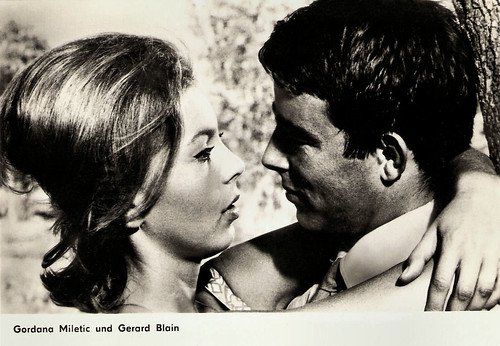
East-German postcard by VEB Progress Filmvertrieb, no. 2858, 1967. Photo: publicity still for Lo sgarro (Silvio Siano, 1962) with Gordana Miletic.
A rebel actor
In the early 1960s, Gérard Blain went to Hollywood to play alongside John Wayne in Hatari! (Howard Hawks, 1962). Blain was unable to adapt to the American star system, refused to sign a contract and returned to France. His ideas on cinema were against conformism. Blain was a rebel actor, morally uncompromising, constantly in revolt against his time.
He played fewer and smaller parts, but he continued to act in interesting films such as La Musica/The Music (Marguerite Duras, Paul Seban, 1966) with Delphine Seyrig, and Un homme de trop/Shock Troops (Costa Gravas, 1967) starring Charles Vanel.
He finally could express himself completely with his own film Les Amis/The Friends (Gérard Blain, 1971). His directorial début won the top prize at the Locarno Film Festival. He next directed himself and his two-year-old son Régis in Le pelican/The Pelican (Gérard Blain, 1974). It was nominated for the Golden Bear at the Berlin Film Festival. Blain was a film purist, preferring amateurs to professional actors, against any artificial effect. His films are deeply influenced by director Robert Bresson, whom he admired. His directorial career produced a dozen films, two of which were selected for the Cannes Film Festival, but he never managed to get real popular success.
According to French Wikipedia, Gérard Blain is considered by some as a ‘right-wing anarchist’ because of his unconventional ethics. At the Cannes Film Festival in 1987, he created a controversy with the film Pierre et Djemila/Peter and Djemila (Gérard Blain, 1987), written with Michel Marmin and Mohamed Bouchibi. While he directed he also continued to play in films by other directors. Among these films are Der amerikanische Freund/The American Friend (Wim Wenders, 1977), the crime film Poussière d'ange/Angel Dust (Edouard Niermans, 1987) starring Bernard Giraudeau, and his final film Bandits d'amour/Love Bandits (Pierre Le Bret, 2001).
At 70, Gérard Blain died of cancer in his hometown Paris in 2000. He had been married four times: he married and quickly divorced Micheline Estellat aka actress Estella Blain (1953-1956), actress Bernadette Lafont (1957-1959), and Monique Sobieski (1960-?). His fourth and final marriage was with Marie-Hélène Bauret (1985-2000) (his death). He had five sons from these marriages, of whom two died young. The others, Paul, Régis and Pierre, all worked with him on his films.
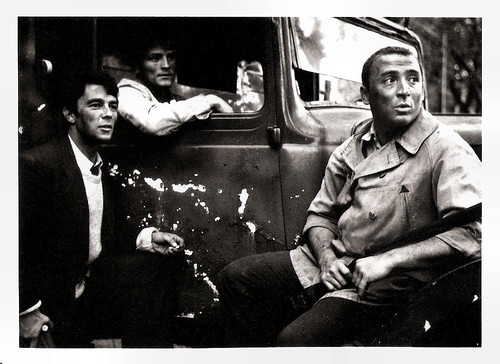
French postcard by Edition Librairie de la Fontaine, Paris, no. 141 (limited edition of 250 ex.). Photo: Claude Schwartz / Spadem. Gerard Blain, Jacques Perrin and Claude Brasseur in Un homme de trop/Shock Troops (Costa-Gravas, 1966).
Trailer Les Cousins (1958). (No subtitles). Source: Eureka Entertainment (YouTube).
Trailer Hatari! (1962). Source: Paramount Movies Digital (YouTube).
Sources: James Travers (French Films), Corentin Palanchini (AlloCiné - French), Caroline Hanotte (CinéArtistes - French), Cinememorial (French), Wikipedia (French) and IMDb.
This post was last updated on 2 June 2023.
No comments:
Post a Comment